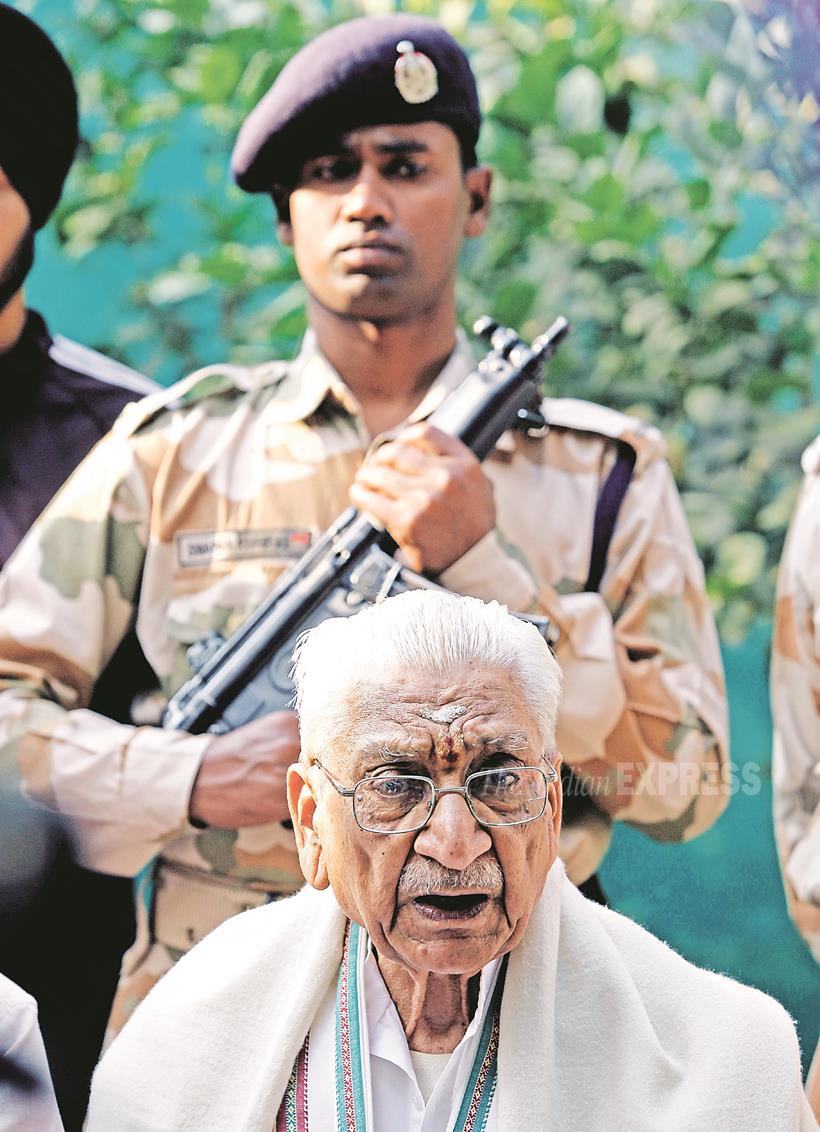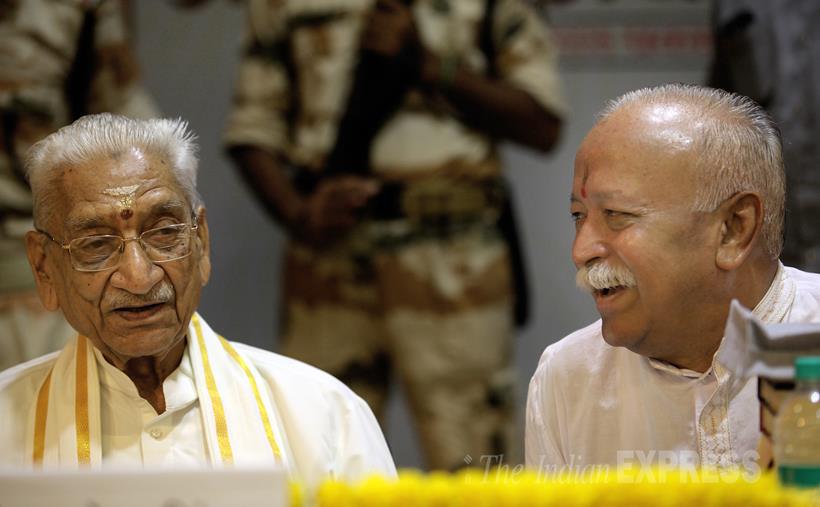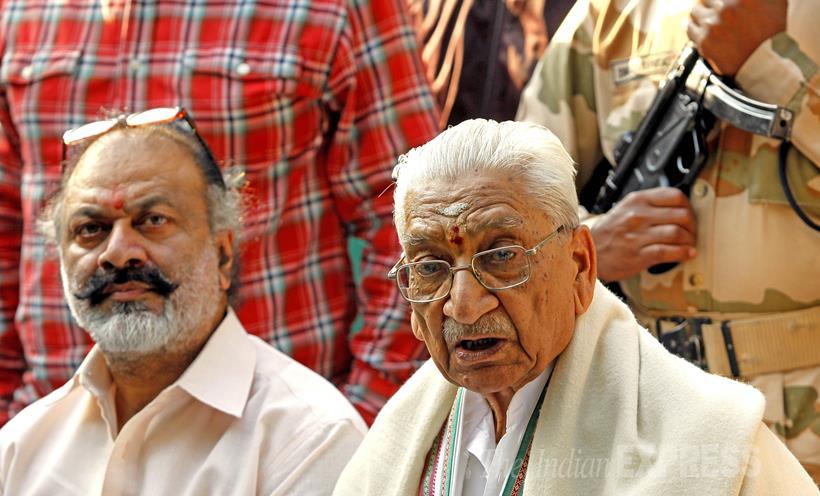 A metallurgy engineer, Ashok Singhal metamorphosed into a Hindutva warrior who as VHP chief played an adequate foil in the Ram Janmabhoomi movement when the BJP led the political campaign in the late eighties and later.
A metallurgy engineer, Ashok Singhal metamorphosed into a Hindutva warrior who as VHP chief played an adequate foil in the Ram Janmabhoomi movement when the BJP led the political campaign in the late eighties and later.
Rajmata Scindia, Ashok Singhal and other leaders of VHP coming out of Rashtrapati Bhawan after meeting the president S.D. Sharma. (Source: Express Archive photo)
 Seen in this picture – Ashok Singhal, Uma Bharti, L.K. Advani, Murli Manohar Joshi and Vinay Katiyar at BJP Office after their arrival in Delhi. (Source: Express Archive Photo)
Seen in this picture – Ashok Singhal, Uma Bharti, L.K. Advani, Murli Manohar Joshi and Vinay Katiyar at BJP Office after their arrival in Delhi. (Source: Express Archive Photo)
 The 89-year-old right-wing firebrand leader, Ashok Singhal, dedicated his life for the Hindutva cause adopting an aggressive style and played a key role in mobilising support for the Ram Janambhoomi as well as the Ram Setu movements.
The 89-year-old right-wing firebrand leader, Ashok Singhal, dedicated his life for the Hindutva cause adopting an aggressive style and played a key role in mobilising support for the Ram Janambhoomi as well as the Ram Setu movements.
Seen here with Murli Manohar Joshi and Ashok Singhal at Yajna Jain Samaj for Mandir on Midnight of July 18, 1992. (Source: Express Archive photo) –
 It was under Singhal’s stewardship that the international branding of VHP was conceptualised for which he recruited supporters and established offices abroad. The VHP got immense contribution from outside India for its campaign.
It was under Singhal’s stewardship that the international branding of VHP was conceptualised for which he recruited supporters and established offices abroad. The VHP got immense contribution from outside India for its campaign.
Seen in this picture – Ashok Singhal, Swami Vandeo Maharaj and Ram Sunder Dass at the press conference of Ram Janam Bhoomi Nayasmanch in Delhi. (Source: Express Archive photo)
 Singhal was instrumental in the “kar sewak” campaign that led to the bringing down of the 16th century Babri Masjid in Ayodhya on December 6, 1992.
Singhal was instrumental in the “kar sewak” campaign that led to the bringing down of the 16th century Babri Masjid in Ayodhya on December 6, 1992.
In this file photo, Vishav Hindu Parishad Suprimo Ashok Singhal is seen at a press conference in Faridabad. (Source: Express Archive photo)
Born in Agra on October 2 in 1926, Singhal has a Bachelor’s degree in Metallurgical Engineering from Banaras Hindu University Institute of Technology in 1950. (Source: Express Archive photo)
Having been associated with the Rashtriya Swayamsevak Sangh (RSS) since 1942, Singhal became a full-time pracharak after his graduation. He worked in various locations around Uttar Pradesh, becoming a prant pracharak for Delhi and Haryana. (Source: Express Archive Photo)
 In 1980, Singhal was deputed to VHP and became its Joint General Secretary. In 1984, he became its General Secretary and later elevated to the post of its working President, a role in which he continued till December 2011.
In 1980, Singhal was deputed to VHP and became its Joint General Secretary. In 1984, he became its General Secretary and later elevated to the post of its working President, a role in which he continued till December 2011.
In this picture, Ashok Singhal is seen at Lucknow airport after arrest by police on Saturday, August 24, 2013. (Source: Express Archive Photo)
 Attached to the RSS, Ashok Singhal was inspired by its ideology throughout his life and was a prominent member of the Sangh Parivar.
Attached to the RSS, Ashok Singhal was inspired by its ideology throughout his life and was a prominent member of the Sangh Parivar.
In this file photo, Ashok Singhal made his presence at a VHP organised Yagya and protest against the mishandling of Baba Ramdev’s protests at the Ram Lila maidan in New Delhi June 7, 2011. (Source: Express Archive Photo)
 VHP leaders considered Ashok Singhal their “guide and visionary” as he led many a movement during his lifetime. He was instrumental in playing a key role in launching an Andolan in Uttar Pradesh against the Emergency and also the ‘Gau-Raksha Andolan’ for the protection of cows.
VHP leaders considered Ashok Singhal their “guide and visionary” as he led many a movement during his lifetime. He was instrumental in playing a key role in launching an Andolan in Uttar Pradesh against the Emergency and also the ‘Gau-Raksha Andolan’ for the protection of cows.
In this picture, Ashok Singhal is seen addressing a press conference in Chandigarh on Thursday, November 15, 2012. (Source: Express Archive Photo)
 Singhal continued to play an active role in VHP and remained its patron till the end. Incidentally, a few days prior to being admitted to the hospital, Singhal undertook a 30-day tour of various countries to oversee the VHP activities.
Singhal continued to play an active role in VHP and remained its patron till the end. Incidentally, a few days prior to being admitted to the hospital, Singhal undertook a 30-day tour of various countries to oversee the VHP activities.
VHP President Ashok Singhal addressing a press conference in Chandigarh on Thursday, November 15, 2012. (Source: Express Archive Photo)
 Entrusted to work for VHP in 1980, Singhal turned active after the Meenakshipuram conversions in 1981 in Tamil Nadu when VHP built 200 temples for Dalits specifically and claimed that conversions stopped thereafter.
Entrusted to work for VHP in 1980, Singhal turned active after the Meenakshipuram conversions in 1981 in Tamil Nadu when VHP built 200 temples for Dalits specifically and claimed that conversions stopped thereafter.
Union home minister Rajnath Singh and RSS chief Mohan Rao Bhagwat felicitating VHP leader Ashok Singhal on the occasion of his entering into 90th year of his life in new Delhi on Thursday October 1, 2015. (Source: Express Archive Photo)
 Singhal played the role of a key organiser of VHP’s first ‘Dharma Sansad’ in 1984 in Delhi that attracted hundreds of Sadhus and Hindu Saints to discuss the rejuvenating of Hinduism. (Source: Express Archive Photo)
Singhal played the role of a key organiser of VHP’s first ‘Dharma Sansad’ in 1984 in Delhi that attracted hundreds of Sadhus and Hindu Saints to discuss the rejuvenating of Hinduism. (Source: Express Archive Photo)
 It was here that the movement for reclaiming the Ramjanambhoomi temple at Ayodhya was born and Singhal soon emerged as the chief architect of the Ramjanambhoomi movement.
It was here that the movement for reclaiming the Ramjanambhoomi temple at Ayodhya was born and Singhal soon emerged as the chief architect of the Ramjanambhoomi movement.
Seen here with RSS chief Mohan Bhagwat, Ashok Singhal and Smriti Irani at the launch of books of Dr. B.S. Shastri in New Delhi on September 7, 2014. (Source: Express Archive Photo)
 The VHP opened branches in 40 nations from east to to west, including in countries like the United States, the United Kingdom, France and Germany to Indonesia and Japan among other countries under Singhal’s leadership.
The VHP opened branches in 40 nations from east to to west, including in countries like the United States, the United Kingdom, France and Germany to Indonesia and Japan among other countries under Singhal’s leadership.
Seen in this picture – Union Home Minister Rajnath Singh with VHP leader Ashok Singhal at a programme in Lucknow. (Source: PTI)
 Ashok Singhal was also a trained vocalist in Hindustani music, who had his training from the legendary Pandit Omkarnath Thakur.
Ashok Singhal was also a trained vocalist in Hindustani music, who had his training from the legendary Pandit Omkarnath Thakur.
VHP President Ashok Singhal addressing a press conference in Chandigarh on Thursday, November 15, 2012. (Source: Express Archive Photo)
 As RSS Pracharak, Ashok Singhal remained a bachelor.
As RSS Pracharak, Ashok Singhal remained a bachelor.
Seen in this picture – Ashok Singhal, Mahant Avaidyanath, Kanchikamkoti Shankracharya and other sadhus during a meeting of Ram Janambhumi dispute. (Source: Express Archive Photo)







